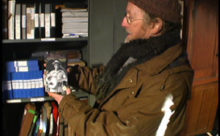John Cohen on Robert Frank & Photography
"The late 1950s were a transitional time in photography. I was raised in an earlier time. My ideas were before 1959. It was in the mid '50s that I started photographing. I was in full swing in Peru in 1956. That was probably the same time that Robert Frank was doing The Americans. I didn't know what he was doing then. I knew his earlier work. And I was his neighbor when I came back to New York.
I hope people have heard of The Americans. Robert Frank showed me tons of photographs, but they were new to me. We were friends. He photographed the New Lost City Ramblers, and I photographed his wife's sculpture. We did things for each other.
He was presenting a view of America that was more like a poem. It would be easy for me to say that he was presenting the antithesis of middle-class life, but I don't think that was what drove him. He wasn't from middle-class America. He was from middle-class Switzerland. But he had an idea of what it meant to be an artist himself. And so he went through America looking at things.
You asked me to explain how his photos hit me. It is very hard to explain in words. But interestingly Jack Kerouac wrote an introduction for Robert's book in second edition. I think Kerouac said something like 'Robert Frank, Swiss funny guy, has sucked a sad poem out of America.'"
(Editor's note: Kerouac's introduction says, "Robert Frank, Swiss, unobtrusive, nice, with that little camera that he raises and snaps with one hand he sucked a sad poem right out of America onto film, taking rank among the tragic poets of the world.")
I think he says it nicely there. It is the grimness of the reality all over America. Maybe what people would not acknowledge as the hard nature of our lives. Robert was merciless. He was critical as can be, but he wasn't mocking people. He was nailing the situation. You have a guy in a diner slopping soup into his mouth and on the next page you would have a woman in her pearls at a society ball. It was slightly sociologically jarring. But he wasn't doing it to be a sociologist. He was doing to look at America. I think he was also doing what I was doing - Is this what we want? Is this what we value?
He wasn't pointing out that these poor people were valueless. But he was making people who were in power feel nervous, about the power they had by pointing out the reality.
You know if I had I would pull off the very first edition of The Americans. I had that book when it first came out in 59. And you would see the pages all fall out because I opened that book up so many times in 28 years of photography students and went through it page by page looking at photographs with them. Now my book isn't worth anything anymore. A clean copy is worth $4000 or $5000. Mine is worth more because I shared it with hundreds of photography students."
